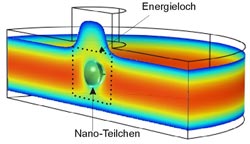A giant step in a miniature world: UZH researcher measures the electrical charge of nano particles

Cross-section through two chip-sized glass plates in which a nano particle is trapped in an energy hole (or “potential well” to use the scientific term). The colored fields show the different charges in the electrostatic field. The red zone signifies a very low charge, while the blue edges have a strong charge.<br>picture: UZH<br>
Prof. Krishnan has developed a new method that measures not only the size of the particles but also their electrostatic charge. Up until now it has not been possible to determine the charge of the particles directly. This unique method, which is the first of its kind in the world, is just as important for the manufacture of drugs as in basic research. The process has now been introduced for the first time in the «Nature Nanotechnology» journal.
In order to observe the individual particles in a solution, Prof. Madhavi Krishnan and her co-workers «entice» each particle into an «electrostatic trap». It works like this: between two glass plates the size of a chip, the researchers create thousands of round energy holes. The trick is that these holes have just a weak electrostatic charge. The scientists than add a drop of the solution to the plates, whereupon each particle falls into an energy hole and remains trapped there. But the particles do not remain motionless in their trap. Instead, molecules in the solution collide with them continuously, causing the particles to move in a circular motion. «We measure these movements, and are then able to determine the charge of each individual particle», explains Prof. Madhavi Krishnan.
Put simply, particles with just a small charge make large circular movements in their traps, while those with a high charge move in small circles. This phenomenon can be compared to that of a light-weight ball which, when thrown, travels further than a heavy one. The US physicist Robert A. Millikan used a similar method 100 years ago in his oil drop experiment to determine the velocity of electrically charged oil drops. In 1923, he received the Nobel Prize in physics in recognition of his achievements. «But he examined the drops in a vacuum», Prof. Krishnan explains. «We on the other hand are examining nano particles in a solution which itself influences the properties of the particles».
Electrostatic charge of «nano drugs packages»
For all solutions manufactured industrially, the electrical charge of the nano particles contained therein is also of primary interest, because it is the electrical charge that allows a fluid solution to remain stable and not to develop a lumpy consistency. «With our new method, we get a picture of the entire suspension along with all of the particles contained in it», emphasizes Prof. Madhavi Krishnan. A suspension is a fluid in which miniscule particles or drops are finely distributed, for example in milk, blood, various paints, cosmetics, vaccines and numerous pharmaceuticals. «The charge of the particles plays a major role in this», the Zurich-based scientist tells us.
One example is the manufacture of medicines that have to be administered in precise doses over a longer period using drug-delivery systems. In this context, nano particles act as «packages» that transport the drugs to where they need to take effect. Very often, it is their electrical charge that allows them to pass through tissue and cell membranes in the body unobstructed and so to take effect. «That’s why it is so important to be able to measure their charge. So far most of the results obtained have been imprecise», the researcher tells us.
«The new method allows us to even measure in real-time a change in the charge of a single entity», adds Prof. Madhavi Krishnan. «This is particularly exciting for basic research and has never before been possible». This is because changes in charge play a role in all bodily reactions, whether in proteins, large molecules such as the DNA double helix, where genetic make-up is encoded, or cell organelles. «We’re examining how material works in the field of millionths of a millimeter».
Literature:
Mojarad, N, and Krishnan, M., Measuring the size and charge of single nanoscale
objects in solution using an electrostatic fluidic trap. Nature Nanotechnology (2012)
http://www.nature.com/nnano/journal/vaop/ncurrent/full/nnano.2012.99.html, doi:10.1038/nnano.2012.99
Contact:
Prof. Dr. Madhavi Krishnan
Universität Zürich
Physikalisch-chemisches Institut
Phone: +41 44 635 44 65
e-mail: madhavi.krishnan@ uzh.ch
Media Contact
All latest news from the category: Life Sciences and Chemistry
Articles and reports from the Life Sciences and chemistry area deal with applied and basic research into modern biology, chemistry and human medicine.
Valuable information can be found on a range of life sciences fields including bacteriology, biochemistry, bionics, bioinformatics, biophysics, biotechnology, genetics, geobotany, human biology, marine biology, microbiology, molecular biology, cellular biology, zoology, bioinorganic chemistry, microchemistry and environmental chemistry.
Newest articles

Pinpointing hydrogen isotopes in titanium hydride nanofilms
Although it is the smallest and lightest atom, hydrogen can have a big impact by infiltrating other materials and affecting their properties, such as superconductivity and metal-insulator-transitions. Now, researchers from…

A new way of entangling light and sound
For a wide variety of emerging quantum technologies, such as secure quantum communications and quantum computing, quantum entanglement is a prerequisite. Scientists at the Max-Planck-Institute for the Science of Light…

Telescope for NASA’s Roman Mission complete, delivered to Goddard
NASA’s Nancy Grace Roman Space Telescope is one giant step closer to unlocking the mysteries of the universe. The mission has now received its final major delivery: the Optical Telescope…



